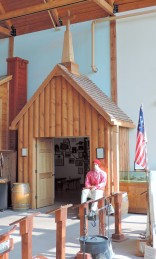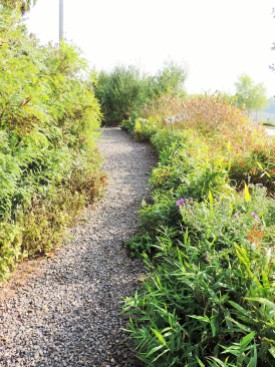- Adventure 1-The Lewis and Clark National Historic Trail
- Destination 2-Lewis & Clark Boat House and Nature Center
Our next stop at sites along the Lewis and Clark National Historic Trail takes us to St. Charles, Missouri. St. Charles is the oldest city on the Missouri River, having been founded in 1769 by Louis Blanchette, a French-Canadian fur trader. When he founded the city, he called it “Les Petites Cotes”, “The Little Hills”.
It was from St. Charles, that a group of men called the Corps of Discovery, departed on May 21, 1804, on the epic journey we call the Lewis and Clark Expedition. The purpose of their journey was to explore the western continent newly acquired by the United States. In the words of President Thomas Jefferson to Meriwether Lewis:
The object of your mission is to explore the Missouri river, & such principal stream of it, as, by it’s course and communication with the waters of the Pacific ocean…may offer the most direct & practicable water communication across this continent for the purpose of commerce.
Today, St. Charles is a vibrant city that has managed to retain much of its history and tradition. Main Street is still laid with bricks, and all manner of shops and restaurants line both sides of the street for its entire length. Frontier Park is on the banks of the Missouri River in St. Charles, and is a gathering place for festivals, picnics, and leisurely walks. Sunrise on the Missouri at Frontier Park can be a beautiful site.
But… back to the Boat House! The first thing you will notice as you approach the building is the large first floor space enclosed in iron bars. This is where the reconstructed boats of the Expedition are kept: the keel boat and two pirogues. The keel boat is 55 feet long and has a carrying capacity of twelve to fourteen tons. The boats at the Boat House are the boats you will see in an upcoming mini-series about the Lewis and Clark Expedition being filmed by HBO.
From viewing the boats, you will climb the stairs to the museum and the museum store. Inside the museum are displays relating to the Corps of Discovery and the city of St. Charles.
The museum is full of interesting information about the Lewis and Clark Expedition, as well as information about early St. Charles and the Missouri River.
As you enter the museum, you can pick up a guide full of questions. As you tour the museum looking for the answers to the questions…I call it an information scavenger hunt…you will learn about the Corps of Discovery through interactive activities, models, murals, displays and dioramas.
And, of course, there is a museum store. The Trading Post at The Boat House is full of many items pertaining to the Lewis and Clark Expedition to tempt both children and adults. I almost never get out of there without something, especially if I spend any time at all in the book section.
As we left the museum and the boats behind, we took a little time to walk through the garden in front of the building. The gardens highlight those plants that grow and thrive in a flood plain. A sign in the garden explains that many of the plants have roots that go six to ten feet down into the soil, and that many of the plants have survived three floods and a drought. You will also see an old canoe hollowed out from one large tree trunk. One of my favorite things outside the museum are the numerous pieces of driftwood. The Missouri River carries a lot of sediment as it flows through the western American continent to join the Mississippi River not far from St. Charles. The pieces of wood which come down with this sediment are broken down and smoothed to form, what I think are, pieces of art made by nature itself.
So, as you venture out this year to “Find Your Park”, maybe you will consider the Lewis and Clark Historic Trail, and The Boat House and Nature Center in St. Charles, MO, which lays along this national treasure. You can learn more about The Lewis and Clark Boat House and Nature Center on their website at http://www.lewisandclarkcenter.org/
*Provision Pork Stew with Cornmeal Dumplings
When the Corps of Discovery left on their epic journey, they carried with them 3,705 pounds of pork, more than any other commodity. It was their go-to item on those days when the men sent out to hunt dinner came back empty-handed. This stew may have been a second choice, but it is really good. My husband and I eat it often as a “first choice”.
Pork Stew
- 2 lbs. pork butt, trimmed and cut into 1 inch cubes
- 1/4 c. stone-ground cornmeal
- 1 tsp. salt
- 1/2 tsp. black pepper
- 2-3 Tbsp. vegetable oil
- 2 onion, peeled and cut into eighths
- 4 cups beef broth
Place the pork in a plastic bag with the cornmeal, salt, and pepper. Shake the bag until all the pork is covered in the cornmeal mixture.
Heat the oil in a Dutch oven at medium-high heat. Lightly brown the pork on all sides. Add the onions and cook until they soften, stirring often. This will take between 8 and 10 minutes, and you may need to reduce the heat a bit to keep the onions from burning.
Add the beef broth and simmer over medium-low heat for about an hour.
This stew tastes best if you refrigerate it overnight. When it is dinner time, just skim the fat from the top and heat for at least 20 minutes, stirring often. Do not allow the bottom to burn. While the stew is heating, prepare the dumplings.
Cornmeal Dumplings
- 1 c. flour
- 1/4 c. stone-ground yellow cornmeal
- 1 tsp. baking powder
- 1/2 tsp. salt
- 1 Tbsp. melted butter
Mix the flour, cornmeal, baking powder, and salt. Stir in 1/3 cup of water and the melted butter, just until moistened.
Gently drop spoonfuls of dough on top of the stew as it simmers over medium-high heat…I do this with my fingers. Cover tightly, lower the heat to medium-low, and cook for about 10 minutes…DO NOT LIFT THE LID. Serve immediately. Serves 4-6
Enjoy!
*This recipe was adapted from The Food Journal of Lewis & Clark: Recipes for an Expedition, by Mary Gunderson. It was published in 2003 by History Cooks in Yankton, SD.


















